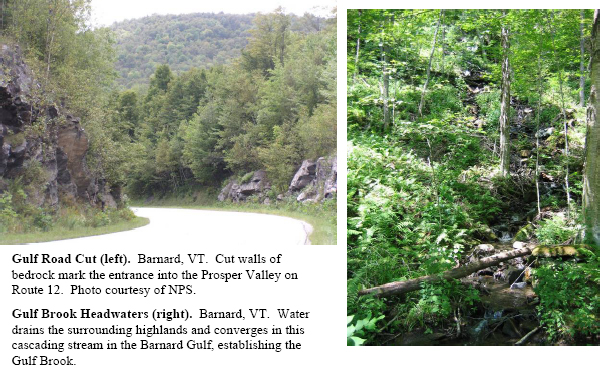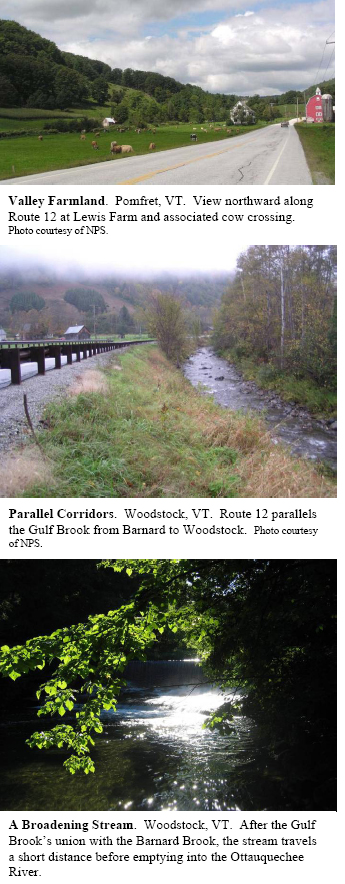THE PROSPER VALLEY VIGNETTES:
At Home in the Valley - An Introduction
My love affair with this valley began with a herd of cattle. I had just gotten a job in Woodstock and was driving along Route 12 to look at an apartment in Barnard. At the urging of a flashing yellow light, I slowed my car to a stop in front of a line of cows crossing the road. At the time, I didn't know that I would take the apartment and travel this corridor every day for a year, eventually becoming familiar with every turn in the river and every slope on the surrounding hills. I also didn't know that I would return to this valley three years later to do my master's research, this time leaving my car behind and donning a pair of hiking boots to explore the same stream and hills in greater depth. In that moment as I watched the cows cross the road, I only knew that the valley already felt like home.

Each morning on my drive south to Woodstock, I crested the hill near the Barnard Gulf and coasted down the steep grade into the basin I now know as the Prosper Valley. Driving past the cut walls of bedrock exposed by past road crews, moose crossing signs,

and forests of red spruce trees, I began to piece together an understanding of this new landscape. At the bottom of the big hill, Route 12 joins Gulf Brook in an interweaving dance across forest and farmland until the stream empties into the Ottauquechee River near Billings Farm in Woodstock. Along the way, many feeder streams converge with the Gulf, draining their associated highlands and defining narrower east-west valleys. Progressing roughly nine miles on a gradual downhill towards Woodstock, the landscape changes; the rock cuts, moose crossing signs and red spruce are replaced by a widened valley, cow crossing signs, and fields of wildflowers. Each day, I was awe-struck by the beauty of green fields against blue sky; by the way evening sunlight lit up the autumn foliage like wildfire; by the furry creatures that occasionally darted out in front of my car; and by the patches of uninterrupted forestland. That first year, my love affair with the Valley was new and, like many new loves, it was based entirely on attraction. I left the region for other employment in 2004 and I'll admit that I became enamored with other places. But none had such a hold on my heart as the narrow valley connecting the four towns of Barnard, Bridgewater, Pomfret, and Woodstock.
When I returned to the Valley for the summer of 2006 I wanted more. I wanted to delve deeper—past the good looks—to begin really understanding the Valley. My purpose was to learn about its natural landscape and cultural history so I could share them with the local community in a celebration of their place. I traipsed through lowlands and highlands collecting knowledge of the landscapes pieces—tree species, rock types, animals, land uses… I took note of the way these pieces organize into patterns on the land—red spruce forests at the high elevations, black bears on the ridgelines… I racked my brain over the thousands of processes that could be responsible for the landscape patterns that I saw—climate, ancient continental collisions, ice storms, and land development… And then it happened—I started to make connections. I grasped how an ancient geological story explained the presence of some of the wildflowers I saw throughout the Valley and I understood how a more recent agricultural story explained many of the common forest types. I began to consider water the Valley's lifeblood and started thinking of the highlands and lowlands as an interconnected watershed, with each parcel of land connected to the others by the flow of water. All in all, I started to understand the whole system as the integration of three different landscapes—the physical landscape (bedrock and glacial geology), the natural landscape (soil, vegetation, and wildlife), and the cultural landscape (dealings of people through time).
This past summer of field work seasoned my relationship with the Prosper Valley—the black flies made sure it wasn't all sunshine and roses—but the feeling I am left with, after returning to my Burlington university life, is a deepened connection to that corner of the world. The Valley and I now have a shared history; I'll notice a smell in the wind that takes me back to the fields of wildflowers atop Dana Hill or I'll encounter dankness in the air that turns my thoughts to bygone investigations of Bridgewater cellar holes. Now my task is simple—to share my stories of the Prosper Valley landscape with people who also consider it "home". It is my hope that these stories spark, rekindle, or stoke your love affair with this valley.